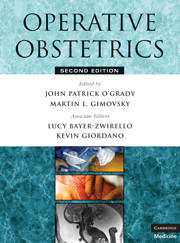Book contents
- Frontmatter
- Contents
- Foreword
- Preface
- Acknowledgments
- Contributors
- Part I ANTEPARTUM
- Part II INTRAPARTUM AND POSTPARTUM
- Chapter 9 Obstetric Anesthesia
- Chapter 10 Labor
- Chapter 11 The Third Stage
- Chapter 12 Breech Presentation
- Chapter 13 Multiple Gestation
- Chapter 14 Shoulder Dystocia
- Chapter 15 Intrapartum and Postpartum: Legal Commentary II
- Part III SURGICAL PROCEDURES
- Part IV SPECIAL ISSUES
- APPENDIX
- Index
- Plate section
- References
Chapter 10 - Labor
from Part II - INTRAPARTUM AND POSTPARTUM
Published online by Cambridge University Press: 07 May 2010
- Frontmatter
- Contents
- Foreword
- Preface
- Acknowledgments
- Contributors
- Part I ANTEPARTUM
- Part II INTRAPARTUM AND POSTPARTUM
- Chapter 9 Obstetric Anesthesia
- Chapter 10 Labor
- Chapter 11 The Third Stage
- Chapter 12 Breech Presentation
- Chapter 13 Multiple Gestation
- Chapter 14 Shoulder Dystocia
- Chapter 15 Intrapartum and Postpartum: Legal Commentary II
- Part III SURGICAL PROCEDURES
- Part IV SPECIAL ISSUES
- APPENDIX
- Index
- Plate section
- References
Summary
Keywords
- Type
- Chapter
- Information
- Operative Obstetrics , pp. 232 - 256Publisher: Cambridge University PressPrint publication year: 2008

